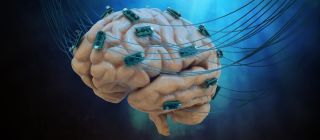Depression
Non-Invasive Brain Stimulation: Hope for Depression?
Further research on TMS and tDCS could revolutionize depression treatment.
Posted January 12, 2024 Reviewed by Gary Drevitch
Key points
- Major depressive disorder is a debilitating condition affecting 10-15 percent of the population per year.
- Pharmacological treatment options for depression remain limited.
- Non-invasive brain stimulation like TMS and tDCS could revolutionize treatment.

Co-authored by Amir Afkhami and Andrew Guggenheim
Major depressive disorder is a serious debilitating mental health condition affecting 10-15% of the population per year.1 This illness, typified by persistently depressed mood and reduced interest in daily activities, causes significant functional impairments and diminished quality of life. Pharmacological treatment options for depression remain limited due to the inadequate development of new classes of antidepressants and the inability of existing medications on the market to fully allay symptoms of depression in every individual. Patients with treatment-resistant depression, characterized by insufficient control of their symptoms after two adequate trials (both in dosage and duration) of two different classes of antidepressant therapy, are particularly vulnerable.2 Research shows that these individuals have poor functional outcomes, with increased rates of unemployment, suicidal ideation, substance misuse, and unstable relationships.3 With only 60-70% of patients with major depressive disorder responding to current antidepressants on the market, new approaches to treating this illness are urgently needed.1,4
Transcranial magnetic stimulation (TMS) and transcranial direct current stimulation (tDCS) are two of the more frequently studied and used noninvasive brain stimulation (NIBS) therapies in clinical practice.5 Both treatment modalities are believed to play a role in the regulation of aberrant functional connectivity within the fronto-limbic system, which has a key role in the pathophysiology of depression. 6-10 Prolonged use of either treatment modality leads to a sustained change in cortical excitability that outlasts the period of stimulation.11
TMS produces cortical stimulation by delivering an electrical current through a coiled wire placed on the scalp that generates a magnetic field, which alters neuronal activity in the brain. Dosage determination is calibrated to the person-specific motor-evoked potential (MEP) threshold. 12-14 The generated magnetic field is ~1.5 Tesla, similar to a standard magnetic resonance imaging (MRI) machine. The TMS protocol typically calls for patients to undergo five daily treatment sessions over the course of three to six weeks for a total of 20 to 30 sessions.3 In contrast with TMS, tDCS exerts its neuromodulatory effects by delivering a weak electrical current through anodal and cathodal electrodes, which are inserted into a moistened holding bag and placed on the scalp using the International 10-20 system. The density of the current used typically ranges between 0.02-0.08 mA/cm2, and is used as a marker of dosage. 13, 15 Typical tDCS protocols call for the administration of 20-28 treatment sessions.16
Several clinical trials have shown that patients with major depressive disorder could be successfully treated after undergoing daily TMS to their prefrontal cortex, with remission rates ranging from 20-30%, and with fewer side effects than traditional antidepressant therapy.3,14 A randomized multicenter control study found a four-fold increase in depression remission and significant improvement in depressive symptoms when comparing patients who received TMS to placebo.3 Of note, a multicenter observational study involving 307 patients in a clinical setting found that therapeutic responses were maintained in patients treated with TMS.14, 17-18 This study also found a clinician-assessed response rate (CGI-S) of 58%, a symptom remission rate of 37%, and a patient-reported positive response rate ranging from 41.5 to 56.4%.19 The efficacy of tDCS, by contrast, has been considerably less investigated. One randomized single-blind clinical trial comparing self-administered tDCS to sham tDCS found the degree of symptomatic improvement in patients with major depressive disorder to be significantly higher in the treatment (non-sham) group.20 A larger study comparing tDCS to antidepressant therapy, SELECT-TDCS, found that combining sertraline and tDCS was superior to all other groups.21 Another study comparing TMS, tDCS, and antidepressants (venlafaxine) revealed no statistically significant differences in efficacy between the three treatment modalities.5
Although TMS has a well-established and robust body of research supporting its efficacy in treating major depressive disorder, the procedure places a higher burden of time and cost on patients due to its requirement of daily clinical visits. tDCS, on the other hand, has been less investigated, but the limited evidence in the literature appears to show comparable efficacy to TMS and, maybe more importantly, a lower barrier of access for patients since it can be self-administered. Both treatments have relatively limited side effects, with the most common being mild and temporary. These results call for further research, not only to add to the body of data comparing the efficacy of the two procedures, but also to investigate the potentially amplified benefit of using the TMS and tDCS conjointly to treat cases of treatment-resistant depression. Further investigation and increased clinical implementation of these new interventions hold the promise of reducing the burden of treatment, particularly among treatment-resistant patients suffering from major depressive disorder, and improved access to potentially life-saving interventional therapeutics for a larger population of underserved patients.
Andrew Guggenheim is a student at the George Washington University School of Medicine and Health Sciences.
References
1. Al-Harbi K. S. (2012). Treatment-resistant depression: therapeutic trends, challenges, and future directions. Patient preference and adherence, 6, 369–388.
2. Souery D, Amsterdam J, deMontigny C, et al. Treatment resistant depression: methodological overview and operational criteria. Eur Neuropsychopharmacol. 1999;9:83–91
3. Rizvi, S., & Khan, A. M. (2019). Use of Transcranial Magnetic Stimulation for Depression. Cureus, 11(5), e4736.
4. McClintock SM, Reti IM, Carpenter LL, et al. Consensus recommendations for the clinical application of repetitive transcranial magnetic stimulation (rTMS) in the treatment of depression. J Clin Psychiatry. 2018;79(1):35. doi:10.4088/JCP.16cs10905
5. Čukić M. (2020). The Reason Why rTMS and tDCS Are Efficient in Treatments of Depression. Frontiers in psychology, 10, 2923.
6. Bluhm, R., Williamson, P., Lanius, R., Théberge, J., Densmore, M., Bartha, R., et al. (2009). Resting state default-mode network connectivity in early depression using a seed region-of-interest analysis: decreased connectivity with caudate nucleus. Psychiatr. Clin. Neurosci. 63, 754–761. doi: 10.1111/j.1440-1819.2009.02030.x
7. Berman, M. G., Peltier, S., Nee, D. E., Kross, E., Deldin, P. J., and Jonides, J. (2011). Depression, rumination and the default network. SCAN 6, 548–555. doi: 10.1093/scan/nsq080
8. Chen, C., Takahashi, T., Nakagawa, S., Inouea, T., and Kusumia, I. (2015). Reinforcement learning in depression: a review of computational research. Neurosci. Biobehav. Rev. 55, 247–267 doi: 10.1016/j.neubiorev.2015.05.005
9. Zhang, J., Wang, J., Wu, Q., Kuang, W., Huang, X., He, Y., et al. (2011). Disrupted Brain connectivity networks in drug-naive, first-episode major depressive disorder. Biol. Psychiatr. 70, 334–342. doi: 10.1016/j.biopsych.2011.05.018
10. Priori, A., Hallett, M., & Rothwell, J. C. (2009). Repetitive transcranial magnetic stimulation or transcranial direct current stimulation? Brain stimulation, 2(4), 241–245.
11. Hallett M. Transcranial magnetic stimulation: a primer. Neuron. 2007;55:187–199. doi: 10.1016/j.neuron.2007.06.026.
12. Elder, G. J., & Taylor, J. P. (2014). Transcranial magnetic stimulation and transcranial direct current stimulation: treatments for cognitive and neuropsychiatric symptoms in the neurodegenerative dementias? Alzheimer's research & therapy, 6(9), 74.
13. George MS, Taylor JJ, Short EB. The expanding evidence base for rTMS treatment of depression. Curr Opin Psychiatry. 2013 Jan;26(1):13-8. doi: 10.1097/YCO.0b013e32835ab46d. PMID: 23154644; PMCID: PMC4214363.
14. Stagg CJ, Nitsche MA. Physiological basis of transcranial direct current stimulation. Neuroscientist. 2011 Feb;17(1):37-53. doi: 10.1177/1073858410386614. PMID: 21343407.
15. Alonzo A, Fong J, Ball N, Martin D, Chand N, Loo C. Pilot trial of home-administered transcranial direct current stimulation for the treatment of depression. J Affect Disord. 2019 Jun 1;252:475-483. doi: 10.1016/j.jad.2019.04.041. Epub 2019 Apr 10. PMID: 31005790.
16. Demitrack, M. A., & Thase, M. E. (2009). Clinical significance of transcranial magnetic stimulation (TMS) in the treatment of pharmacoresistant depression: synthesis of recent data. Psychopharmacology bulletin, 42(2), 5–38.
17. Connolly, K. R., Helmer, A., Cristancho, M. A., Cristancho, P., & O'Reardon, J. P. (2012). Effectiveness of transcranial magnetic stimulation in clinical practice post-FDA approval in the United States: results observed with the first 100 consecutive cases of depression at an academic medical center. The Journal of clinical psychiatry, 73(4), e567–e573.
18. Carpenter, L. L., Janicak, P. G., Aaronson, S. T., Boyadjis, T., Brock, D. G., Cook, I. A., Dunner, D. L., Lanocha, K., Solvason, H. B., & Demitrack, M. A. (2012). Transcranial magnetic stimulation (TMS) for major depression: a multisite, naturalistic, observational study of acute treatment outcomes in clinical practice. Depression and anxiety, 29(7), 587–596.
19. Oh, J., Jang, K. I., Jeon, S., & Chae, J. H. (2022). Effect of Self-administered Transcranial Direct Stimulation in Patients with Major Depressive Disorder: A Randomized, Single-blinded Clinical Trial. Clinical psychopharmacology and neuroscience : the official scientific journal of the Korean College of Neuropsychopharmacology, 20(1), 87–96.
20. Brunoni, A. R., Valiengo, L., Baccaro, A., Zanão, T. A., de Oliveira, J. F., Goulart, A., Boggio, P. S., Lotufo, P. A., Benseñor, I. M., & Fregni, F. (2013). The sertraline vs. electrical current therapy for treating depression clinical study: results from a factorial, randomized, controlled trial. JAMA psychiatry, 70(4), 383–391. https://doi.org/10.1001/2013.jamapsychiatry.32


